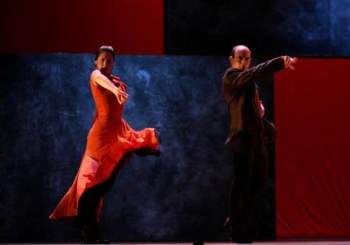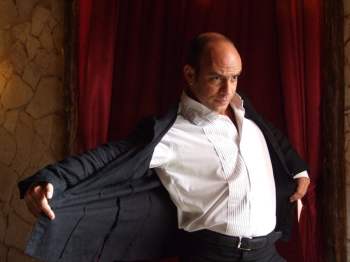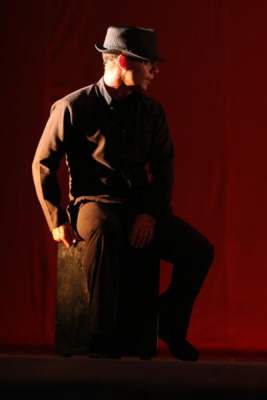In Defense of Flamenco in Cuba
By Helson Hernandez

HAVANA TIMES, March 1 — We Interviewed Danny Villalonga, currently one of the most applauded male figures of flamenco in Cuba. He is the principal dancer and director of the Ecos dance troupe.
HT: How did the story of the principal dancer and the director of the Ecos dance company begin?
Danny Villalonga: It began when I was 18, when I was invited to the 15th birthday party of my cousin Anisley Garcia. Back then, in 1994, she was one of the principal dancers with the Lizt Alfonso Ballet. Her director was there and she offered me the chance to begin training at her school, given the need for a greater male presence in the few companies that were devoted to that genre of Spanish dance.
I didn’t agree to it initially because I was finishing my studies. Though the specialty I had studied for four years didn’t thrill me a whole lot, I felt that it was something solid for beginning my professional life. The world of dance had never entered my mind; I was always distant from it and I’d never even taken a class. Up to that point I was only attracted by the gypsies I’d seen in TV series and at the movies.
A few days went by and I was invited by Anisley to visit the theaters where this and other companies were being presented. I was struck by this expression of dance, and I decided to cast my fate with it. I was going to try my luck, taking a risk, while thinking that if I made the wrong decision I would feel sorry later – I was no longer at the age for playing games.

A little more a year after beginning my dance studies I left that company to continue my learning in the Spanish Ballet of Havana, currently the Spanish Ballet of Cuba, where I was able to work as a professional dancer after an additional year of preparation. After four years of having been a member of the most prestigious company of this form of Spanish dance in the country, I — along with other former members of the Ballet — decided to found the first group of pure Flamenco in Cuba: “Ecos.”
I understand that to be more in tune with the flamenco flavor, you and your group lived like gypsies, meaning you had no fixed site for your creative development or for working with the company. Even so, today you’ve achieved a level of mastery that is greatly respected among artists on the island who are involved in the growth of flamenco.
DV: In effect, at the moment of our founding we were practically living in the street. We only had the Andalusian Center of Havana, where we presented our work on Saturday nights and where we were welcomed and supported spiritually and economically by its president, Maria Gomez Santiesteban. This was in 1999.
Starting from that moment we begin the deep and difficult work of bettering ourselves. We wanted to grow in all senses. Our ambition and artistic restlessness increased and we looked for another type of institutional support, which is what would allow us to establish ourselves as a professional company in our country.
We are able to obtain that institutional recognition in a short time and to also win the highest merits, but that didn’t help us obtain better working conditions. The most important and valued thing at that moment was a facility.

We have spent 11 years of hard work, maintaining and improving our artistic level, attracting substantial attendance for our performances and receiving positive critiques from the knowledgeable public – all this despite our not having a dance facility.
Many people asked us how we were able to achieve this. One of the answers is the great love and respect we feel for flamenco. The act of performing Spanish dance for the public is a noble task, though we’re Cuban.
On the other hand, in terms of the material assistance that we need to improve our working conditions, we still don’t have an answer, and that’s the saddest part in our story.
What motivated you to leave an established national company like today’s Spanish Ballet of Cuba to venture into creating something new like Ecos.
DV: There were several reasons. One was that that the Ballet was pursuing an artistic and dance line that no longer stirred our interest. We wanted to better ourselves…to devote ourselves more strongly and more deeply to the flamenco that we were truly passionate about. We also needed another working system that would allow us to take better advantage of time in a general sense, and another reason was the serious economic need that impacted us.
You are moving in two directions within your projection of flamenco: performances conceived for theaters and those for the so-called tablaos (flamenco shows). Tell us about this.
DV: The two forms or concepts of work are very important for us. In performances for theaters we can work on our concepts or realize our ideas through choreographic design, stage work, lighting or effects. This is in addition to our growing in terms of space and corporal projection; we generally exhibit a different and spectacular vision of flamenco.
The other working form, the tablaos, allows us to create works that are based more on improvisation. We have developed thanks to our performing these types of dances more frequently. These also serve us as training exercises, and this is our flamenco school, which makes us dancers with greater experience in a general sense and gives us more knowledge of the language of this genre, which are the tablaos.
Particularly with the tablaos — which are not an accessible form for the entire Cuban public due to higher admission prices at those places and other characteristics — they have won a special space in the historic center of Old Havana, where they can be found fairly often.
DV: We have the opportunity to perform at the Meson de la Flota, a place that has served us well as both a showcase and a barometer of our work. We are there on Fridays, Sundays and Mondays, always in the evening from 8:00 p.m. to 11:00. We are also very concerned about the prices and the type of currency that this place charges, since most of our public following is unable to attend our presentations. Outside of this situation, we’ve been able to win foreign followers, who have larger incomes.
Do you think the lack of attention given to flamenco is related to the little interest shown by the media in Cuba in covering this art form and its cultures?
DV: Yes, and in fact I think the media shows more interest in what moves the masses than in what could raise our cultural level or could offer support to artists who uphold our traditions…our roots.

People no longer think of doing this type of educational work, although it takes time. Me, being a faithful defender of flamenco and not considering myself a “cultured” person, I believe that we urgently need to elevate our cultural level. In this way we will raise our living standard, making our work develop and taking it to the level it really deserves. Also for this sad reason, people tend to confuse flamenco with any degeneration that is seen or heard on television or the radio.
You have premiered your most important performances at the Gran Teatro of Havana. The last of these turned out to be an interesting combination of Cuban and Iberian elements, uniting the roots of the two cultures.
DV: It was the result of new reflections, an experiment that turned out well for us thanks to the effort and the innovative spirit of the company’s artists. Ana Rosa Meneses, the prima ballerina and the artistic director of this performance, “Flamenco Cuba,” won the congratulations of our faithful followers.
With such a high level of work in its staging, why hasn’t your company done more to expand its international profile?
DV: We are constantly exploring that projection and people have expressed interest in our work abroad, but in the end I don’t know why anything hasn’t materialized. I think we need to find a good manager or representative or an international sponsor who is interested in our artistic work; someone sensitive and sincere.
HT: And are you now working on your next premiere?
DV: We don’t lack desire, but we are short of the proper conditions for training and creating, though we’ll be able to surprise people once again with a new direct blow to the hearts of those who follow Ecos.






danny i am inmspired by your art form and your words. where do i write to find out program dates in april 2012 si u can attend an ecos performance. i willl privileged and full of joy to attend a performance in the sevilla hotel. such heart warming memories. please email me your contact person for the group.
I have fond memories of watching Ecos. The first time I saw them back in 2002 was truly special. My wife and I had come into town hoping to catch a play at the Bertolt Brecht Theater. We lived only 15 miles out on the east side of the city but it would often take two hours or more including waiting for the bus.
By the time we got into Vedado it was already getting close to show time. It was also raining pretty hard. While trying to find the theater we got lost and were stuck on a street with the water ankle deep. We had pretty much given up when we got back to Linea and A Street and noticed the Mella Theater had a Flamenco performance about to begin.
We were totally drenched from head to toe but not wanting to face the bus stop without having seen anything we decided to go in. The theater was pretty full but we got seats up close and it was fabulous. Ecos made us forget the wet clothes and picked up our moods immediately. We left the theater still wet but smiling.
Circles